Try these mouth-watering Pakistani dishes this Eid ul Adha
Geo.tv compiles a list of mouth-watering dishes for you to try out this Eid ul Adha
July 20, 2021
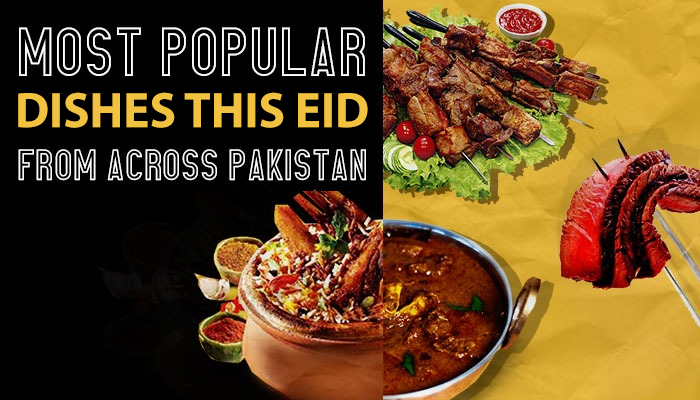
With Eid ul Adha just around the corner, animals bought and qasais booked, foodies are now searching for meal ideas to mark the special occasion.
In a bid to help its readers, Geo.tv took the liberty to prepare a list of appetizing dishes from all over the country.
x Advertisement
Here is a compilation of Pakistan’s most famous meatilicious food items for Eid, all the way from Karachi to Kashmir.
Kaleji
When it comes to Eid ul Adha, kaleji (liver) is a must for almost all households. It is often the first sizzling item cooked right after qurbaani and its irresistible aroma fills the air early in the morning. It is also a dainty yet energising Eid breakfast for many people.
Cooking kaleji is a common tradition throughout the country but it is especially popular in Sindh and Punjab.
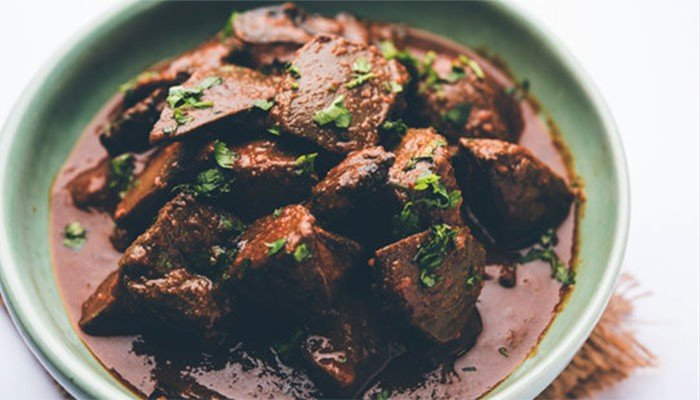
Most people prefer to cook kaleji immediately after qurbaani because a fresh liver doesn't smell bad. Sharing tips to get rid of the foul odour if cooking it later, cooking experts say one must rub salt on it before washing it. Adding garlic and fresh coriander while cooking can also help get rid of the smell.
Here's a quick and easy Kaleji recipe to serves four people:
Ingredients:
- 500 gm mutton/beef washed liver
- 1/2 tsp ginger paste
- 1/2 tsp garlic paste
- 1/2 tsp chilli powder
- 1/4 cup yoghurt
- 1/4 tsp garam masala
- Salt to taste
- 2 tbsp ghee
- 1/2 cup grated onions
- 2 tbsp coriander leaves to garnish
Method:
Cut the kaleji into pieces and add ginger, garlic, chilli powder, yoghurt, garam masala and salt. Sauté onions till golden-brown in ghee and add the kaleji. Fry until the oil separates from the spices. Finally, add half a cup of water and pressure cook for 5 minutes. Dry the water completely, garnish and serve.
Paye
Paye is an all-time favourite all over the sub-continent, especially in Punjab.
Made from the hoofs of goats and beef, this soupy dish will leave you craving for more. While pressure cookers have reduced the cooking time, many people still like to slow cook it, sometimes overnight and have it for breakfast or lunch. The dish is best served with naan — hot from the tandoor.
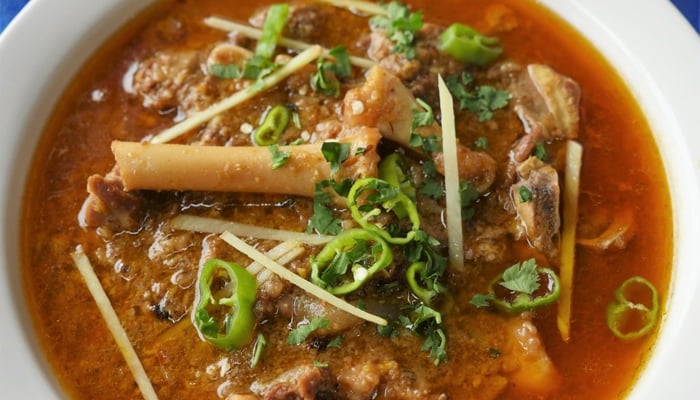
Here's a recipe for you to try this Eid.
Ingredients:
- 1/2 cup Ghee
- 2 Onion (grind them)
- 1-1/2 tbsp Garlic
- 1 tbsp Ginger
- 6 Paye
- 1 ½ tbsp Red chilli powder
- 2tsp Salt
- 1 tsp Turmeric powder
- 1 cup Yoghurt
- 6-7 cups Water
- ½ tbsp Whole spice powder
- Fresh coriander (for garnishing)
- Green chillies (for garnishing)
- Ginger (julienne) (for garnishing)
- Lemon wedges
Method:
Clean and wash the paye. In a big pan, fry the onions until golden brown in ghee. Add ginger paste, garlic paste and sauté for 2-3 minutes. Then, add the paye. After that add the spices, yoghurt and mix well. Now add 6-7 cups of water and cook on low flame for 3-4 hours. Dish and garnish, the Paye are ready to serve.
Lamb sajji
Sajji is the speciality of Balochistan which is devoured throughout the year across Pakistan. For the people of the province, Eid can never be complete without the traditional ‘Balochi Sajji’.
The tempting Sajji is traditionally made by roasting a whole sheep under mud for several hours. Once baked, the tender meat leaves people craving for more. While it's traditionally made with mutton, some people also make it with chicken.
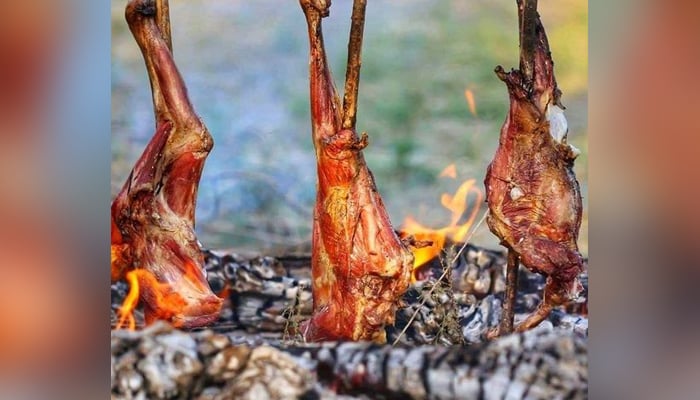
Speaking to Geo.tv, a Mozambique-based Pakistani housewife Sadaf Saqib, who runs a food page on Instagram, said that she is especially excited for Eid this time as she'd be celebrating it in Pakistan after six years. Therefore, she'd be cooking sajji to make the event a memorable one.
"I’m looking forward to making the Balochi sajji or masala raan for the whole family," said Saqib.
Although difficult to prepare, the dish is definitely a must-have on your Eid table. Here’s a recipe for you to try out.
Ingredients:
- 1 ½ kg Leg of lamb
- ¼ cup Lemon juice
- ¾ cup White vinegar
- 3 tbsp Ginger garlic paste
- 1 tbsp Meat tenderiser
- Lemon slices and chat masala – for garnish
Method:
Wash and clean the leg of the lamb. Make slits in the meat and soak in water. Then add ¼ cup lemon juice, vinegar, ginger-garlic, salt and meat tenderiser, mix well and apply on lamb leg. Finally, bake in preheated oven at 150º c for an hour. Serve with lemon and chaat masala.
The lamb leg can also be cooked covered in aluminium foil and surrounded by coals.
Roghan Josh
Roghan Josh is one of the signature curries from Kashmir. Typically made with lamb or mutton, this dish is prepared by adding golden-brown onions to the meat, followed by spices and yoghurt. The liberal use of Kashmiri red chillies imparts a dramatic red colour to the dish, making it savoury and overly tempting.
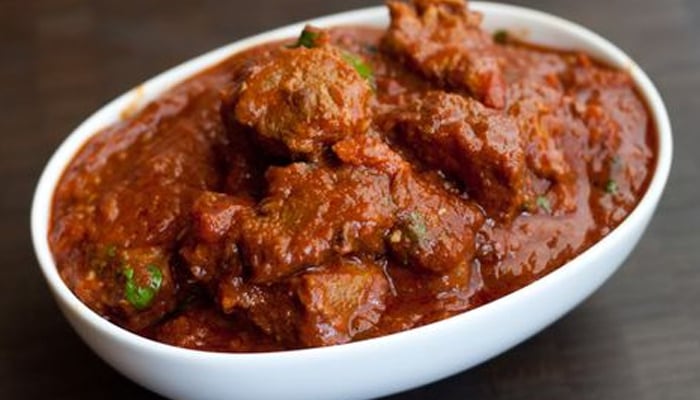
Roghan josh was originally brought to Kashmir by the Mughals and has been a favourite since then. It can both be served with rice and roti and can be the perfect dinner idea for the first day of Eid ul Adha.
Ingredients:
- 1 kg mutton, chopped into cubes
- 2 cinnamon
- 5 black cardamom
- 1 1/4 teaspoon ginger powder
- 150 gm yoghurt
- Salt to taste
- 1 1/2 cup water
- 2 1/2 tablespoon milk
- 1/2 cup ghee
- 1 1/4 teaspoon cumin seeds
- 1 teaspoon peppercorns
- 4 red chillies
- 1 1/4 tablespoon coriander powder
- 2 pinch saffron
- 1 tablespoon red chilli powder
- 1 1/2 tablespoon fennel seeds powder
- 1 1/4 tablespoon all-purpose flour
Method:
Heat ghee in a pressure cooker and add whole spices to fry them for a few seconds. Add whole red chillies and cumin seeds to it and fry for a few more seconds. Now add the pieces of mutton and stir well. Partially cover with a lid and let it simmer for about 5-6 minutes on medium to high flame. Remove the lid and add 1/2 cup of water. Lower the flame and cook the mutton for another 10-15 minutes.
Mix saffron in milk, add all-purpose flour and yoghurt. Mix well. Next, add salt, fennel powder, coriander powder, Kashmiri red chilli powder and dry ginger powder. Once all the spices are thoroughly mixed, pour the mixture onto the meat in the pressure cooker. Stir for a minute.
Add 1 cup of water to the pressure cooker and slow cook the mutton for 1-2 hours. Stir in between. You can also pressure cook the mutton for 5-6 whistles. Once done, garnish and serve hot with chapati or naan.
Mumtu dumplings
The mumtu dumplings are a starter delicacy from Gilgit-Baltistan. They comprise steamed dough balls with a stuffing of minced beef or mutton and vegetables.
The dumplings are steamed for several hours and are an excellent addition to the Eid dinner. Traditionally, they are served with yoghurt, parsley, black pepper, vinegar and chilli sauce.
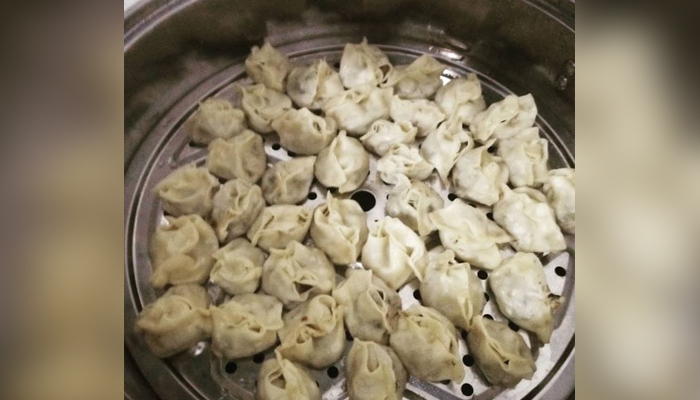
Cooking enthusiast Ufaq Asad told Geo.tv her favourite way to eat the Mumtu dumplings is with soya sauce, vinegar and chilli sauce.
“It’s healthy. I can eat them for every meal, every day," she added. "But cooking it on Eid is the best way to utilise the meat." Here's the recipe:
Ingredients:
- 2 cups ground beef or lamb
- 2/3 cup onions, chopped
- 3 cloves garlic, minced
- 1/2 teaspoon ground black pepper
- 1/2 teaspoon turmeric powder
- 1 teaspoon ground coriander
- Vegetable oil
- Salt to taste
- 1 package of egg roll or wonton wraps
Method:
Heat oil in a pan, add garlic, ground beef, coriander, and salt. Cook for 15 to 20 minutes. Add a few dashes of black pepper to taste and then remove from heat. In a bowl, mix chopped onions and the meat and let it sit until the meat cools down. Cut egg roll wraps into 4-inch diameter circles or squares. Place approximately one tablespoon of the cooled ground meat and onion mixture onto each wrap. Fold and seal the edges.
Next, add water to a steamer and place the dumplings on it. Cover the lid and steam for about 40 minutes.
Chapli kabab and patta tikka
Peshawar is known for its chapli kebabs. What better way to use your meat than to make juicy, tasty kebabs?
The large, flattened ground meat has a crunchy texture due to the presence of coarsely grounded spices, and with a tomato gracing its centre, chapli kebabs serve as the life of lunch tables. Some people prefer it eat it with naan, but it can be savoured on its own too. And we guarantee that you won't stop after eating one of these kebabs, so make sure you prepare ample for the entire family.
Other dishes from Khyber Pakhtunkhwa include Kabuli pulao and patta tikka.
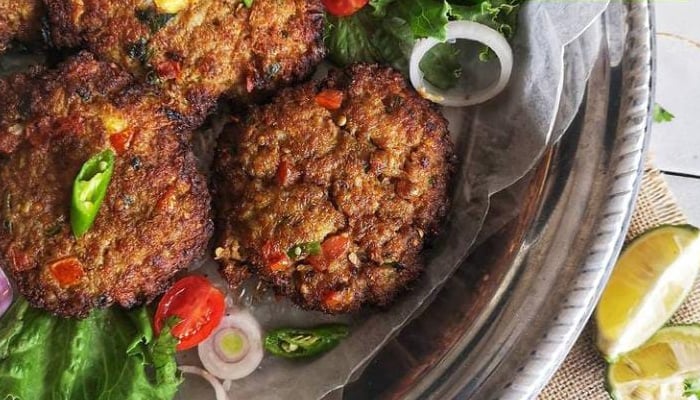
Ali Hasnain, studying culinary arts at the College of Tourism and Hotel Management (COTHM), Karachi, shared his simplest version of patta tikka that only requires, liver, caul fat and salt. The liver is grilled while adding the salt and rolling the caul fat.
Here's the recipe for chapli kebabs:
Ingredients:
- Oil for frying
- 1 egg, lightly beaten
- 1 pound ground beef
- 1 tomato, finely chopped
- 1 red onion, finely chopped
- ¼ cup finely chopped cilantro
- ¼ cup finely chopped mint
- 2 teaspoons ginger-garlic paste
- 2 teaspoons coriander seeds, crushed
- 1 teaspoon salt
- ¾ teaspoon ground cumin
- ¾ teaspoon ground cayenne pepper
- 2 tomatoes, sliced into rounds
Method:
Pour a little oil into a pan and scramble the eggs. Combine all ingredients into the minced meat along with the eggs. Mix by hand until well combined. Shape mixture into patties and press a tomato slice into the centre of each patty. Deep fry and serve hot.
Tikka Boti
Eid ul Adha means at least one BBQ dish with family or friends.
Tikka boti is one of the classic BBQ items. Prepared with either mutton or beef, tender pieces of marinated meat sizzling on the grill are a treat all over the country. The meat is left marinated overnight or for a day which is then ready to be grilled over charcoals.
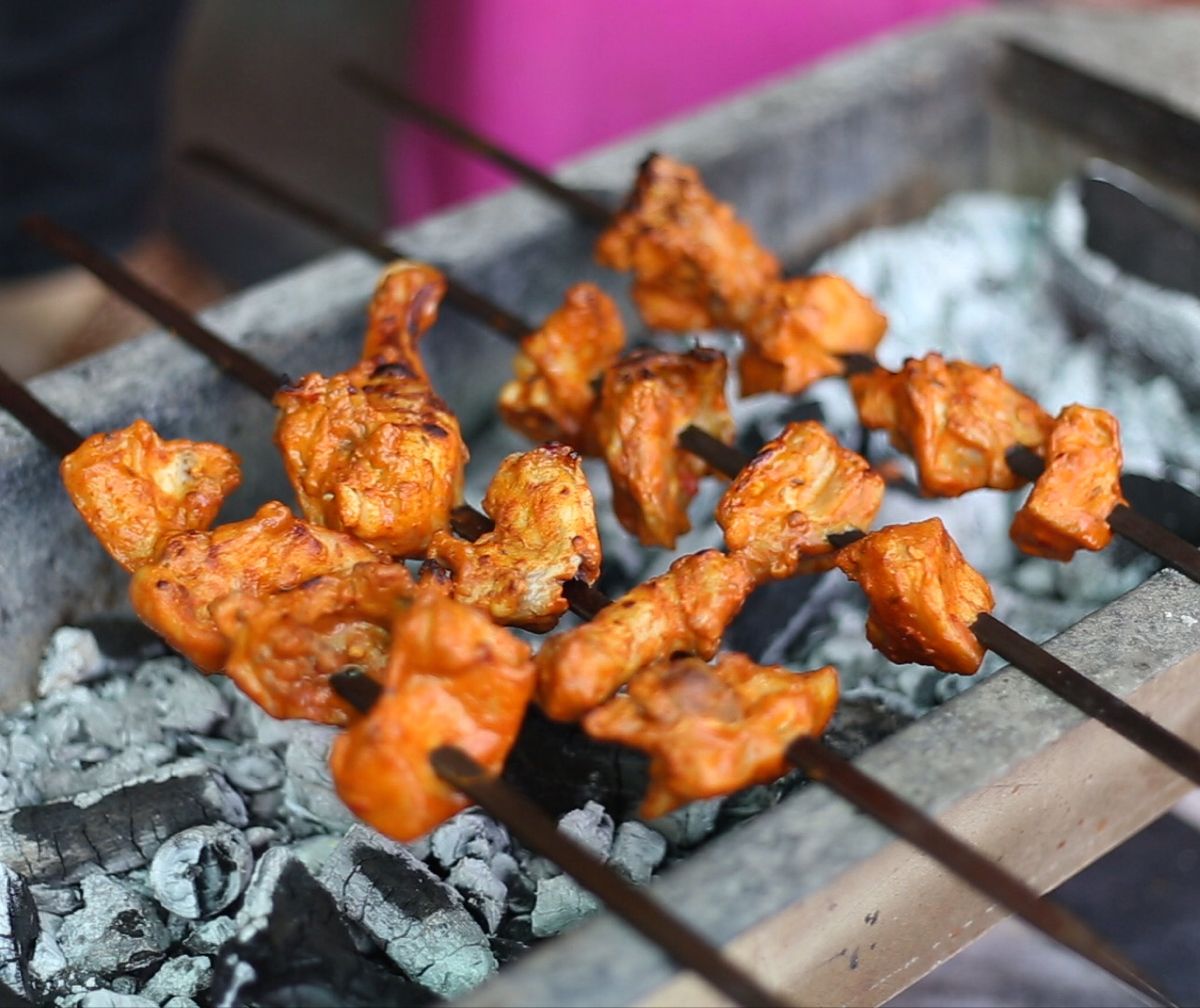
Here is the recipe for a delicious, spicy tikka boti.
Ingredients:
- 1 kg Beef/Mutton boti cubes -
- 2 tbsp Ginger garlic paste -
- 2 tbsp Raw papaya
- 1 packet Tikka boti masala
- 2 tbsp Homemade masala (cumin, coriander and chilli flakes)
- 4 tbsp Lemon juice -
- 4 tbsp Oil
Method:
Mix all the ingredients and leave them in the refrigerator overnight or for several hours. Grill over charcoal.
